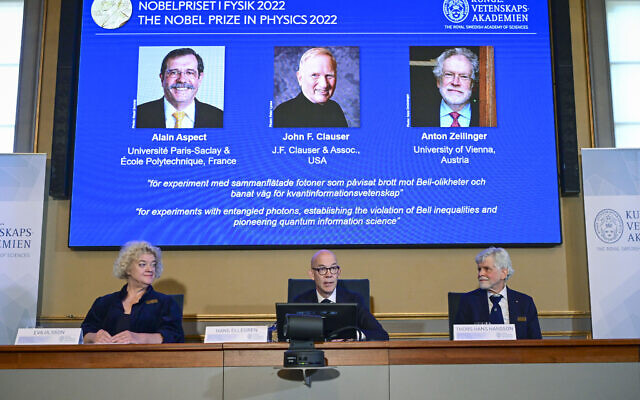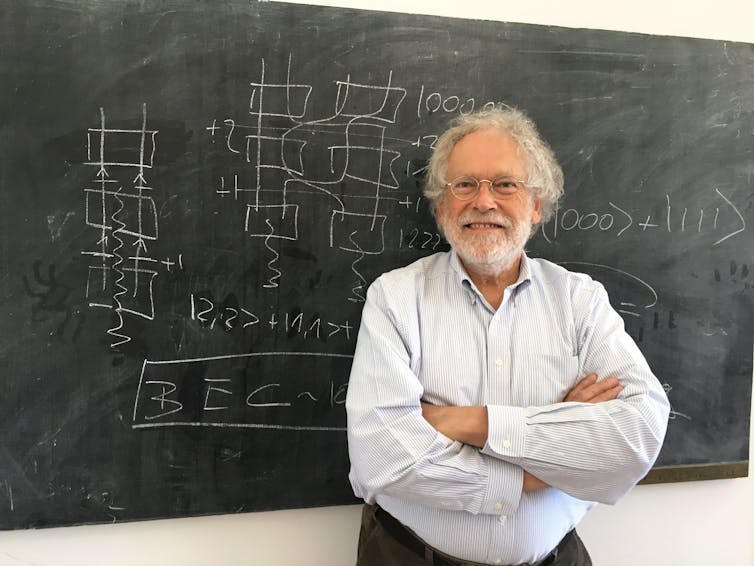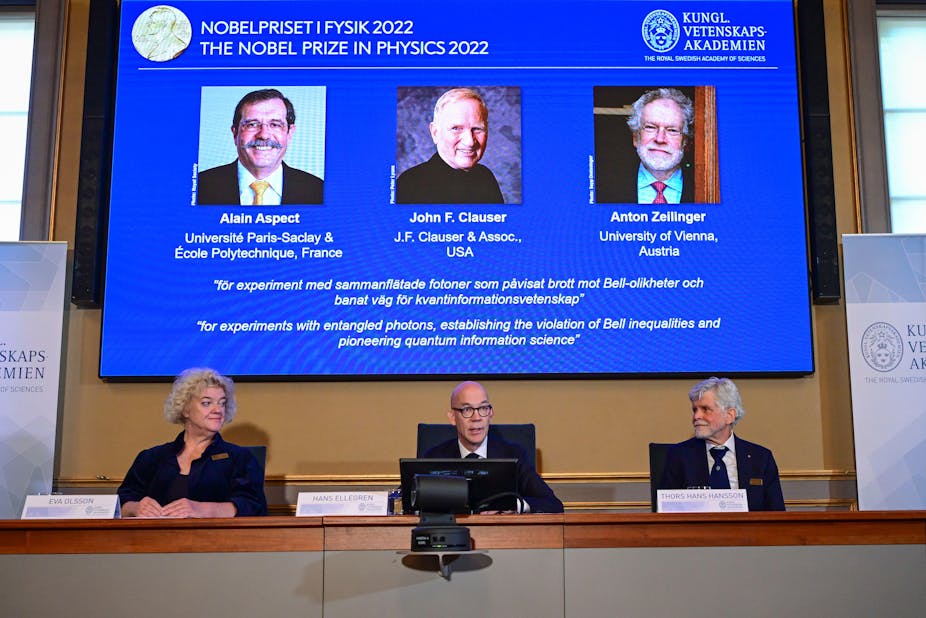Alain Aspect, John F. Clauser, Anton Zeilinger – who previously shared Israel’s Wolf Prize – handed prestigious award for research with implications for secure information transfer
By AP
Today

Royal Swedish Academy of Sciences secretary general Hans Ellegren, center announces the winner of the 2022 Nobel Prize in Physics, from left to right on the screen, Alain Aspect, John F. Clauser and Anton Zeilinger, in Stockholm, Sweden, Oct. 4, 2022.

Royal Swedish Academy of Sciences secretary general Hans Ellegren, center announces the winner of the 2022 Nobel Prize in Physics, from left to right on the screen, Alain Aspect, John F. Clauser and Anton Zeilinger, in Stockholm, Sweden, Oct. 4, 2022.
(Jonas Ekstromer /TT News Agency via AP)
STOCKHOLM — Three scientists jointly won this year’s Nobel Prize in physics on Tuesday for their work on quantum information science that has significant applications, for example in the field of encryption.
Alain Aspect, John F. Clauser and Anton Zeilinger were cited by the Royal Swedish Academy of Sciences for “pioneering quantum information science.”
“Quantum information science is a vibrant and rapidly developing field,” said Eva Olsson, a member of the Nobel committee. “It has broad and potential implications in areas such as secure information transfer, quantum computing and sensing technology.”
“Its origin can be traced to that of quantum mechanics,” she said. “Its predictions have opened doors to another world, and it has also shaken the very foundations of how we interpret measurements.”
Speaking by phone to a news conference after the announcement, Zeilinger said he was “still kind of shocked” at hearing he had received the award.
STOCKHOLM — Three scientists jointly won this year’s Nobel Prize in physics on Tuesday for their work on quantum information science that has significant applications, for example in the field of encryption.
Alain Aspect, John F. Clauser and Anton Zeilinger were cited by the Royal Swedish Academy of Sciences for “pioneering quantum information science.”
“Quantum information science is a vibrant and rapidly developing field,” said Eva Olsson, a member of the Nobel committee. “It has broad and potential implications in areas such as secure information transfer, quantum computing and sensing technology.”
“Its origin can be traced to that of quantum mechanics,” she said. “Its predictions have opened doors to another world, and it has also shaken the very foundations of how we interpret measurements.”
Speaking by phone to a news conference after the announcement, Zeilinger said he was “still kind of shocked” at hearing he had received the award.
“But it’s a very positive shock,” said Zeilinger, 77, who is based at the University of Vienna.
Clauser, Aspect and Zeilinger have figured in Nobel speculation for more than a decade. In 2010 they won the Wolf Prize in Israel, seen as a possible precursor to the Nobel.
While physicists often tackle problems that appear at first glance to be far removed from everyday concerns — tiny particles and the vast mysteries of space and time — their research provides the foundations for many practical applications of science.
Last year the prize was awarded to three scientists — Syukuro Manabe, Klaus Hasselmann and Giorgio Parisi — whose work has helped to explain and predict complex forces of nature, thereby expanding our understanding of climate change.
A week of Nobel Prize announcements kicked off Monday with Swedish scientist Svante Paabo receiving the award in medicine Monday for unlocking secrets of Neanderthal DNA that provided key insights into our immune system.
They continue with chemistry on Wednesday and literature on Thursday. The 2022 Nobel Peace Prize will be announced on Friday and the economics award on Oct. 10.
The prizes carry a cash award of 10 million Swedish kronor (nearly $900,000) and will be handed out on Dec. 10. The money comes from a bequest left by the prize’s creator, Swedish inventor Alfred Nobel, who died in 1895.
Scientist John Clauser, 79, talks about sharing the Nobel physics prize with Alain Aspect and Anton Zeilinger, for experiments in quantum mechanics that laid groundwork for rapidly developing new applications in computing and cryptography.
#NobelPrize #Physics #JohnClauser #Quantum #NobelPhysicsPrize #News #Reuters #newsfeed
Nobel prize: physicists share prize for insights into the spooky world of quantum mechanics

THE CONVERSATION
Published: October 4, 2022

Published: October 4, 2022

Members of the Nobel Committee for Physics announce the winners of the 2022 Nobel Prize in Physics (L-R on the screen) Alain Aspect, John F. Clauser and Anton Zeiling
er. TT News Agency / Alamy Stock Photo
The 2022 Nobel prize for physics has been awarded to a trio of scientists for pioneering experiments in quantum mechanics, the theory covering the micro-world of atoms and particles.
Alain Aspect from Université Paris-Saclay in France, John Clauser from J.F. Clauser & Associates in the US, and Anton Zeilinger from University of Vienna in Austria, will share the prize sum of 10 million Swedish kronor (US$915,000) “for experiments with entangled photons, establishing the violation of Bell inequalities and pioneering quantum information science”.
The world of quantum mechanics appears very odd indeed. In school, we are taught that we can use equations in physics to predict exactly how things will behave in the future – where a ball will go if we roll it down a hill, for example.
Quantum mechanics is different from this. Rather than predicting individual outcomes, it tells us the probability of finding subatomic particles in particular places. A particle can actually be in several places at the same time, before “picking” one location at random when we measure it.
Written by academics, edited by journalists, backed by evidence.Get newsletter
Even the great Albert Einstein himself was unsettled by this – to the point where he was convinced that it was wrong. Rather than outcomes being random, he thought there must be some “hidden variables” – forces or laws that we can’t see – which predictably influence the results of our measurements.
Some physicists, however, embraced the consequences of quantum mechanics. John Bell, a physicist from Northern Ireland, made an important breakthrough in 1964, devising a theoretical test to show that the hidden variables Einstein had in mind don’t exist.
According to quantum mechanics, particles can be “entangled”, spookily connected so that if you manipulate one then you automatically and immediately also manipulate the other. If this spookiness – particles far apart mysteriously influencing each other instantaneously – were to be explained by the particles communicating with each other through hidden variables, it would require faster-than-light communication between the two, which Einstein’s theories forbid.
Quantum entanglement is a challenging concept to understand, essentially linking the properties of particles no matter how far apart they are. Imagine a light bulb that emits two photons (light particles) that travel in opposite directions away from it.
If these photons are entangled, then they can share a property, such as their polarisation, no matter their distance. Bell imagined doing experiments on these two photons separately and comparing the results of them to prove that they were entangled (truly and mysteriously linked).
Clauser put Bell’s theory into practice at a time when doing experiments on single photons was almost unthinkable. In 1972, just eight years after Bell’s famous thought experiment, Clauser showed that light could indeed be entangled.
While Clauser’s results were groundbreaking, there were a few alternative, more exotic explanations for the results he obtained.
If light didn’t behave quite as the physicists thought, perhaps his results could be explained without entanglement. These explanations are known as loopholes in Bell’s test, and Aspect was the first to challenge this.
Aspect came up with an ingenious experiment to rule out one of the most important potential loopholes in Bell’s test. He showed that the entangled photons in the experiment aren’t actually communicating with each other through hidden variables to decide the outcome of Bell’s test. This means they really are spookily linked.
In science it is incredibly important to test the concepts that we believe to be correct. And few have played a more important role in doing this than Aspect. Quantum mechanics has been tested time and again over the past century and survived unscathed.
Quantum technology
At this point, you may be forgiven for wondering why it matters how the microscopic world behaves, or that photons can be entangled. This is where the vision of Zeilinger really shines.
The 2022 Nobel prize for physics has been awarded to a trio of scientists for pioneering experiments in quantum mechanics, the theory covering the micro-world of atoms and particles.
Alain Aspect from Université Paris-Saclay in France, John Clauser from J.F. Clauser & Associates in the US, and Anton Zeilinger from University of Vienna in Austria, will share the prize sum of 10 million Swedish kronor (US$915,000) “for experiments with entangled photons, establishing the violation of Bell inequalities and pioneering quantum information science”.
The world of quantum mechanics appears very odd indeed. In school, we are taught that we can use equations in physics to predict exactly how things will behave in the future – where a ball will go if we roll it down a hill, for example.
Quantum mechanics is different from this. Rather than predicting individual outcomes, it tells us the probability of finding subatomic particles in particular places. A particle can actually be in several places at the same time, before “picking” one location at random when we measure it.
Written by academics, edited by journalists, backed by evidence.Get newsletter
Even the great Albert Einstein himself was unsettled by this – to the point where he was convinced that it was wrong. Rather than outcomes being random, he thought there must be some “hidden variables” – forces or laws that we can’t see – which predictably influence the results of our measurements.
Some physicists, however, embraced the consequences of quantum mechanics. John Bell, a physicist from Northern Ireland, made an important breakthrough in 1964, devising a theoretical test to show that the hidden variables Einstein had in mind don’t exist.
According to quantum mechanics, particles can be “entangled”, spookily connected so that if you manipulate one then you automatically and immediately also manipulate the other. If this spookiness – particles far apart mysteriously influencing each other instantaneously – were to be explained by the particles communicating with each other through hidden variables, it would require faster-than-light communication between the two, which Einstein’s theories forbid.
Quantum entanglement is a challenging concept to understand, essentially linking the properties of particles no matter how far apart they are. Imagine a light bulb that emits two photons (light particles) that travel in opposite directions away from it.
If these photons are entangled, then they can share a property, such as their polarisation, no matter their distance. Bell imagined doing experiments on these two photons separately and comparing the results of them to prove that they were entangled (truly and mysteriously linked).
Clauser put Bell’s theory into practice at a time when doing experiments on single photons was almost unthinkable. In 1972, just eight years after Bell’s famous thought experiment, Clauser showed that light could indeed be entangled.
While Clauser’s results were groundbreaking, there were a few alternative, more exotic explanations for the results he obtained.
If light didn’t behave quite as the physicists thought, perhaps his results could be explained without entanglement. These explanations are known as loopholes in Bell’s test, and Aspect was the first to challenge this.
Aspect came up with an ingenious experiment to rule out one of the most important potential loopholes in Bell’s test. He showed that the entangled photons in the experiment aren’t actually communicating with each other through hidden variables to decide the outcome of Bell’s test. This means they really are spookily linked.
In science it is incredibly important to test the concepts that we believe to be correct. And few have played a more important role in doing this than Aspect. Quantum mechanics has been tested time and again over the past century and survived unscathed.
Quantum technology
At this point, you may be forgiven for wondering why it matters how the microscopic world behaves, or that photons can be entangled. This is where the vision of Zeilinger really shines.

The Austrian quantum physicist Anton Zeilinger stands in his office at the Institute of Quantum Optics and Quantum Information (IQOQI)
dpa picture alliance / Alamy Stock Photo
We once harnessed our knowledge of classical mechanics to build machines, to make factories, leading to the industrial revolution. Knowledge of the behaviour of electronics and semiconductors has driven the digital revolution.
But understanding quantum mechanics allows us to exploit it, to build devices that are capable of doing new things. Indeed, many believe that it will drive the next revolution, of quantum technology.
Quantum entanglement can be harnessed in computing to process information in ways that were not possible before. Detecting small changes in entanglement can allow sensors to detect things with greater precision than ever before. Communicating with entangled light can also guarantee security, as measurements of quantum systems can reveal the presence of the eavesdropper.
Zeilinger’s work paved the way for the quantum technological revolution by showing how it is possible to link a series of entangled systems together, to build the quantum equivalent of a network.
In 2022, these applications of quantum mechanics are not science fiction. We have the first quantum computers. The Micius satellite uses entanglement to enable secure communications across the world. And quantum sensors are being used in applications from medical imaging to detecting submarines.
Ultimately, the 2022 Nobel panel have recognised the importance of the practical foundations producing, manipulating and testing quantum entanglement and the revolution it is helping to drive.
I am pleased to see this trio receiving the award. In 2002, I started a PhD at the University of Cambridge that was inspired by their work. The aim of my project was to make a simple semiconductor device to generate entangled light.
This was to greatly simplify the equipment needed to do quantum experiments and to allow practical devices for real-world applications to be built. Our work was successful and it amazes and excites me to see the leaps and bounds that have been made in the field since.
We once harnessed our knowledge of classical mechanics to build machines, to make factories, leading to the industrial revolution. Knowledge of the behaviour of electronics and semiconductors has driven the digital revolution.
But understanding quantum mechanics allows us to exploit it, to build devices that are capable of doing new things. Indeed, many believe that it will drive the next revolution, of quantum technology.
Quantum entanglement can be harnessed in computing to process information in ways that were not possible before. Detecting small changes in entanglement can allow sensors to detect things with greater precision than ever before. Communicating with entangled light can also guarantee security, as measurements of quantum systems can reveal the presence of the eavesdropper.
Zeilinger’s work paved the way for the quantum technological revolution by showing how it is possible to link a series of entangled systems together, to build the quantum equivalent of a network.
In 2022, these applications of quantum mechanics are not science fiction. We have the first quantum computers. The Micius satellite uses entanglement to enable secure communications across the world. And quantum sensors are being used in applications from medical imaging to detecting submarines.
Ultimately, the 2022 Nobel panel have recognised the importance of the practical foundations producing, manipulating and testing quantum entanglement and the revolution it is helping to drive.
I am pleased to see this trio receiving the award. In 2002, I started a PhD at the University of Cambridge that was inspired by their work. The aim of my project was to make a simple semiconductor device to generate entangled light.
This was to greatly simplify the equipment needed to do quantum experiments and to allow practical devices for real-world applications to be built. Our work was successful and it amazes and excites me to see the leaps and bounds that have been made in the field since.
Author
Robert Young
Professor of Physics and Director of the Lancaster Quantum Technology Centre, Lancaster University
Disclosure statement
Professor of Physics and Director of the Lancaster Quantum Technology Centre, Lancaster University
Disclosure statement
No comments:
Post a Comment